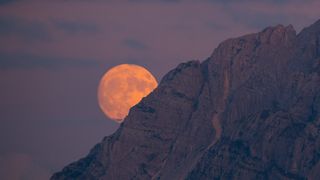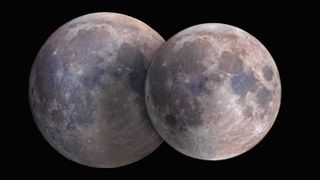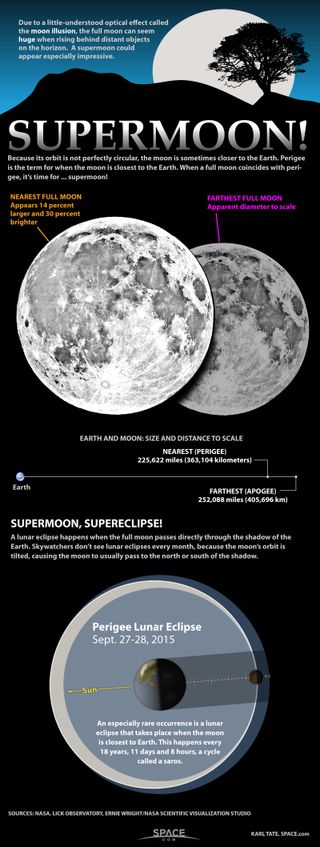Supermoon: what is it and when is the next one?
2024 will experience four supermoons in a row.

When is the next supermoon?
The next supermoon will be on Thursday, Oct. 17 at 7:26 a.m. EDT (1126 GMT.) This will be the third and closest of four supermoons in a row for 2024.
A supermoon occurs when the full moon coincides with the moon being at the point in its orbit within 90% of its closest approach to Earth, called Perigee. This makes the moon appear slightly brighter and closer than usual, though the difference is difficult to notice with the naked eye.
According to Fred Espanak, eclipse expert and retired NASA astrophysicist, there will be four supermoons in 2024, in August, September, October and November.
The closest supermoon this year will occur on Oct. 17, 2024, at 7:26 a.m. ET (11:26 a.m. GMT)
The term "supermoon" has only been used in the past 40 years, but it received a slew of attention in late 2016 when three supermoons occurred in a row. The supermoon of November 2016 was also the closest supermoon in 69 years, although a closer supermoon will rise in the 2030s.
Supermoon 2024 dates
According to data from Fred Espenak's guide, the four supermoons of 2024 will be as follows:
| Name | Date and time | Distance from Earth |
|---|---|---|
| Sturgeon Moon | Aug. 19 at 2:26 p.m. ET (1826 GMT) | 224,917 miles (361,970 km) |
| Harvest Moon | Sept. 17 at 10:34 p.m. ET (0234 GMT on Sept 18) | 222,131 miles (357,486 km) |
| Hunter's Moon | Oct. 17 at 7:26 a.m. ET (1126 GMT) | 222,055 miles (357,364 km) |
| Beaver Moon | Nov. 15 at 4:29 p.m. ET (2129 GMT) | 224,853 miles (361,867 km) |
What causes a supermoon?
The moon's orbit around the Earth is not a perfect circle. It has an average distance of 238,000 miles (382,900 km) from Earth, but its apogee and perigee — the closest and farthest approaches from Earth — change every lunar month.
"The main reason why the orbit of the moon is not a perfect circle is that there are a lot of tidal, or gravitational, forces that are pulling on the moon," said NASA's Noah Petro, deputy scientist of the Lunar Reconnaissance Orbiter mission, in a 2016 Space.com interview.
He added that the different gravities of the Earth, sun and planets all have an effect on the moon's orbit. "You have all of these different gravitational forces pulling and pushing on the moon, which gives us opportunities to have these close passes."

A supermoon needs two key ingredients to occur. The moon needs to be at its closest approach, or perigee, to the Earth in its 27-day orbit. The moon also needs to be at the full phase, which happens every 29.5 days when the sun fully illuminates the moon. Supermoons only happen a few times a year (at most) because the moon's orbit changes orientation while the Earth orbits the sun — that's why you don't see a supermoon every month.
How much larger and brighter is a supermoon compared to a regular full moon?
The moon will appear as much as 30 percent brighter and 14 percent larger than usual, but it's very hard to spot the difference with the naked eye. "That's not enough to notice unless you're a very careful moon-watcher," Sky & Telescope magazine senior editor Alan MacRobert said in a 2016 statement.
The supermoon may look especially large to you, however, if it's very close to the horizon. But that has nothing to do with astronomy and everything to do with how the human brain works. This effect is called the "moon illusion" and may arise from at least a couple of different things. Scientists suggest that perhaps the brain is comparing the moon to nearby buildings or objects, or perhaps our brain is just wired to process things on the horizon as bigger than things in the sky.
Supermoon Q&A with an expert
We asked meteorologist Joe Rao, a few commonly asked questions about supermoons.

Joe Rao is Space.com's skywatching columnist, as well as a veteran meteorologist and eclipse chaser who also serves as an instructor and guest lecturer at New York's Hayden Planetarium.
How often do supermoons occur?
A supermoon is defined as a full moon that coincides (or very nearly so) with lunar perigee — when the moon arrives at that point in its orbit closest to the Earth.
Up until around 2011, this was usually referred to as a perigean full moon. The term supermoon was first coined by an astrologer, who also claimed that full moons occurring at distances within 90% of the perigee distance can also qualify as a supermoon. As a result, there can be more than one supermoon per — typically most years see three; the perigean full moon flanked by supermoons the month before and the month after. Sometimes there can be four supermoons. Rarely, some years can see as few as two or as many as five.
See this comprehensive listing of supermoons from 2000 to 2100 compiled by retired NASA astronomer, Dr. Fred Espenak.
How is a supermoon different from a regular full moon?
Because of its closeness, a supermoon can appear up to 14% larger and 30% brighter compared to a full moon at or near apogee (its farthest point from Earth).
What is the closest and farthest distance the moon can be from Earth?
According to Jean Meeus in his 1997 book "Mathematical Astronomical Morsels" (Willmann-Bell), calculations made from AD 1500 to 2500 show that the moon will be at a minimum distance from Earth of 356,371 km (221,439 miles) on January 1, 2257, and at a maximum distance of 406,720 km (252,724 miles) on January 7, 2266.
Astrological origins
The term "supermoon" didn't originate in astronomy, but in astrology — a pseudoscientific tradition that studies the movements of celestial objects to make predictions about human behavior and events. The term was first mentioned in a 1979 article for Dell Horoscope magazine by Richard Nolle, according to Astronomy.com. Nolle defined a supermoon as "a new or full moon which occurs with the moon at or near (within 90 percent of) its closest approach to Earth in a given orbit", without explaining where he obtained the 90 percent figure.
But it wasn't until the last few years that the term received more attention. A search on Google Trends reveals that starting from 2004, the word "supermoon" was not used often until at least 2011. Interest in the supermoon hit a high in November 2016, when Earth experienced the largest supermoon in 69 years. Further, the term appears to be more popular in certain areas of the world — principally Southeast Asia and North America — with some lesser interest in places such as Europe or India.


Recent astronomical terms such as "supermoon" or "black moon" (the second new moon in a month) could create a perception of "false events" among the public, Cincinatti Observatory outreach astronomer Dean Regas told Space.com in 2016. But Regas, who also co-hosts the PBS program "Star Gazers," said the "supermoon" term is a great public outreach term for astronomy that could have other benefits beyond the event itself.
"It's a great way to get the public interested," he said of the supermoon. "It's something that they can relate to and they can go out and actually see."
Notable supermoons
On Jan. 20-21, 2019, the supermoon coincided with a lunar eclipse. Lunar eclipses occur when the Earth is exactly between the sun and the moon. The moon shines brown-red because the only light it receives is reflected from Earth.
The end of 2016 saw three supermoons in a row in October, November and December. But it was the Nov. 14 one that got the most attention because it was the closest supermoon in recent memory. The moon's perigee was 221,524 miles (356,508 kilometers) from Earth, making it the closest full moon to Earth in 69 years — specifically, since the supermoon of Jan. 26, 1948.
An even closer full moon took place in January 1912; it was roughly 100 kilometers nearer to Earth than in November 2016. But skywatchers who are around in November 2034 will get a special treat, as that moon will be even closer than both the 1912 and 2016 moons.
Additional information
Explore supermoons in more detail with NASA. Discover the supermoon cycle and why the moon can look so big with the Natural History Museum. Find out more about when supermoons occur with TimeandDate.com.
Bibliography
NASA. (2021, July 28). What is a supermoon? – NASA solar system exploration. NASA. Retrieved May 9, 2022.
V. Hocken and A.Kher. What Is a Supermoon and When Is the Next One? Time and Date. Retrieved May 9, 2022.
Berman, B. (2022, May 3). What is a supermoon? Almanac.com. Retrieved May 9, 2022.
Join our Space Forums to keep talking space on the latest missions, night sky and more! And if you have a news tip, correction or comment, let us know at: community@space.com.
Get the Space.com Newsletter
Breaking space news, the latest updates on rocket launches, skywatching events and more!

Daisy Dobrijevic joined Space.com in February 2022 having previously worked for our sister publication All About Space magazine as a staff writer. Before joining us, Daisy completed an editorial internship with the BBC Sky at Night Magazine and worked at the National Space Centre in Leicester, U.K., where she enjoyed communicating space science to the public. In 2021, Daisy completed a PhD in plant physiology and also holds a Master's in Environmental Science, she is currently based in Nottingham, U.K. Daisy is passionate about all things space, with a penchant for solar activity and space weather. She has a strong interest in astrotourism and loves nothing more than a good northern lights chase!
- Elizabeth HowellStaff Writer, Spaceflight
-
rod Jean Meeus, Astronomical Algorithms book (Chapter 48, Perigee and Apogee of the Moon) calculated the lunar perigee and apogee for the period 1500 AD through 2500 AD. Closest approach to Earth using their centers is on 01-January-2257 at 356371 km. Farthest is on 07-January-2266 at 406720 km. The angular size difference is 4.151 arcminute. Max is 33.53 arcminute, min 29.379 arcminute. Lunar perigee this month is 07-April-2020 at 1800 UT, distance 356907 km, angular size 33.48 arcminute. April issue of Sky & Telescope magazine, page 42.Reply
Early today I viewed Mars, Saturn, and Jupiter with my telescope, 0515-0600 EDT, lovely views before clouds started moving in. The waxing gibbous Moon very low in west, setting about 0611 EDT. That moon looked huge (ginormous) to my unaided eyes, perhaps a close super duper-moon :)